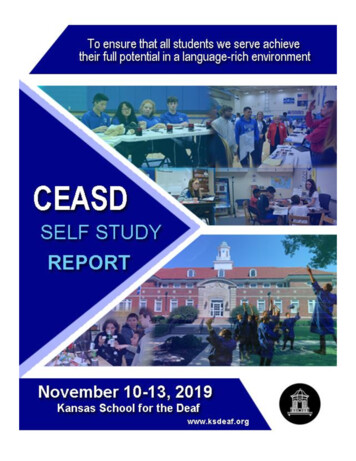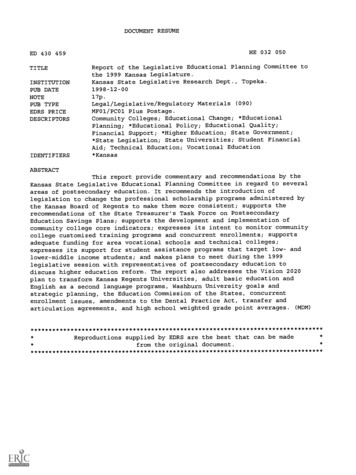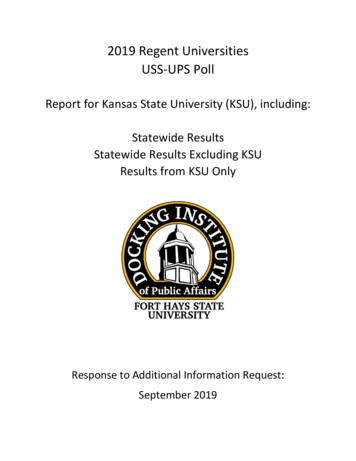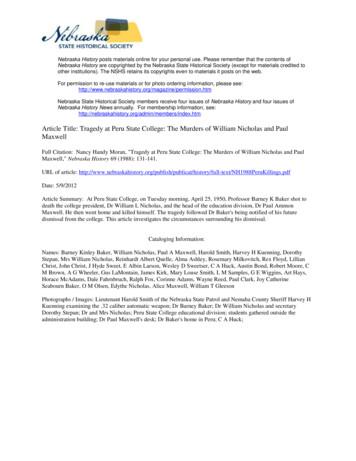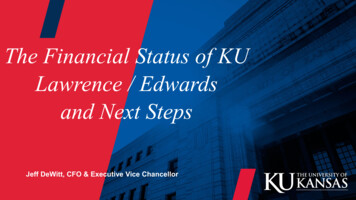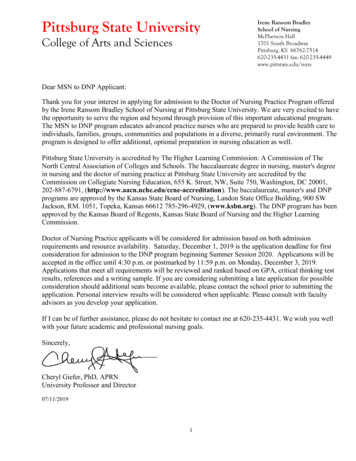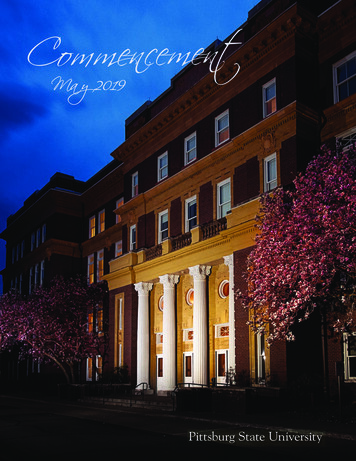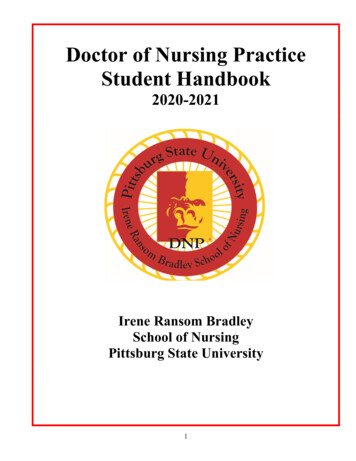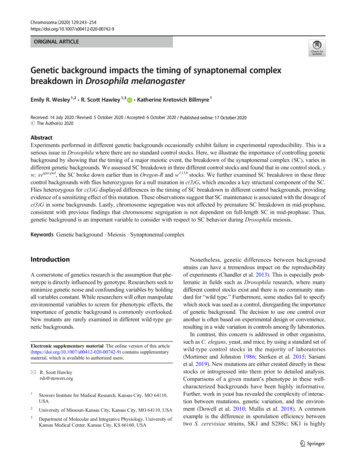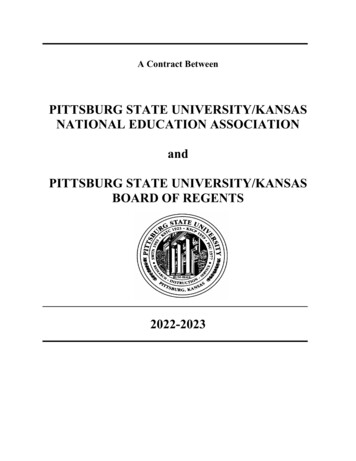
Transcription
A Contract BetweenPITTSBURG STATE UNIVERSITY/KANSASNATIONAL EDUCATION ASSOCIATIONandPITTSBURG STATE UNIVERSITY/KANSASBOARD OF REGENTS2022-2023
TABLE OF CONTENTSI.RECOGNITION .1II.STATEMENT OF EQUAL OPPORTUNITY .2III.ACADEMIC FREEDOM .3IV.SALARIES.4A. FY 2023.4B. Definitions .4C. Annual Performance Appraisal .51. Guidelines and Procedures.5a. Introduction .5b. Procedures .5Goal Setting Process .6Performance Appraisal Process .7Rating Categories .8c. Student Evaluation of Teaching .11d. Timeline for Annual Faculty Performance Appraisal.122. Allocation of Annual Faculty Salary Increments .13V.THE MEET AND CONFER PROCESS AND SALARY GENERATION .14VI.SUMMER EMPLOYMENT PROCEDURE.15VII.OUT-OF-STATE TRAVEL .17VIII.SAFETY .18IX.FACULTY NON-REAPPOINTMENT BECAUSE OF CAUSE, FINANCIALEXIGENCY, AND/OR ACADEMIC PROGRAM DISCONTINUANCE .19A. Introduction .19B. Cause .19C. Academic Program Discontinuance .201. Procedures .202. Faculty Due Process.21D. Retrenchment Due to Financial Exigency .221. Personnel Reduction Procedures .232. Personnel Recall Procedures .23X.PERSONNEL FILES.25XI.RECOMMENDING AND AWARDING TENURE: GUIDELINES ANDPROCEDURES .26i
A. Tenure Guidelines .26l. Tenure Consideration .262. Non-renewal of Contract .27B. Tenure Clock Extensions .27l. Interruptions in Service .272. Delay of Tenure Review.27C. Tenure and Rank .28D. Tenure Procedures .28l. Department/School Committees .282. Initiating Tenure Consideration .283. Tenure Review & Decision Process .304. Tenure Decision .305. Summary of the Tenure Process .316. Timeline for Tenure or Concurrent Tenure & Promotion .32XII.PROMOTION .33A. Promotion Criteria .331. Excellence in Teaching .332. Excellence in Research, Scholarship, and/or Creative Endeavor .343. Excellence in Community, Professional, and/or University Service .34B. Ranks .341. Assistant Professor .352. Associate Professor .353. Professor .35C. Promotion Procedures .36D. Promotion Committees .36l. Department/School Promotion and Tenure Committees .362. College Promotion Committees .373. University Promotion Committees .37E. Application for Promotion.38F. Candidacy for Promotion .38G. Reviewing Candidates for Promotion .39H. Timeline for Promotion-Only Cases .41XIII.THE UNIVERSITY PROFESSOR .42A. Becoming a Candidate to University Professor .42B. Reviewing Candidates to University Professor .43C. Schedule for University Professor .44XIV.MEDICAL AND PARENTAL LEAVE .45XV.FUNERAL LEAVE .48XVI.LIFE INSURANCE .49XVII.ANNUAL LEAVE FOR UNCLASSIFIED EMPLOYEES .50ii
XVIII.RETIREMENT .51A. Retirement Plan .51B. Retirement .51C. Other Benefits .51XIX.HOURS OF WORK.53A. Rationale .53B. Operational Procedures for Instructional Workload .54XX.OTHER PROVISIONS .58A. Graduate and Continuing Studies .58B. Professional Development Moneys .59C. Enrolling in University Courses .59D. University Sponsored Events .59E. Extra Duty Compensation .59F. Annual Summary of Benefits Statement .60G. Recreation Facilities Available .60H. Bookstore Privileges.60XXI.WEARING APPAREL .61A. Policy .61B. Supplies .61XXII.JURY DUTY.62XXIII.WORK SCHEDULE .63XXIV.GRIEVANCE PROCEDURE .64A. General Provisions .64B. Performance Appraisal Grievance Procedure and Merit Salary IncrementGrievance Procedure .651. Scope and Definitions .652. Grievance Process .66Step 1: Formal Appeal to the Dean .66Step 2: Formal Appeal to the Provost and Vice Presidentfor Academic Affairs .67Step 3: Formal Appeal to the President .67Step 4: Formal Appeal for Arbitration .67Step 5: Final Appeal to the President.68Step 6: Completion of Process .683. Advisory Arbitration .68C. General Grievance Procedure .691. Scope and Definitions .692. Grievance Process .69Step 1: Appeal to the Dean .70Step 2: Appeal to the Provost and Vice President for Academic Affairs .70iii
3.Step 3: Appeal for Hearing .70Step 4: Appeal to the President .71Step 5: Completion of Process .71The Grievance Hearing .71XXV.SABBATICAL LEAVE AND LEAVE WITHOUT PAY GUIDELINES ANDPROCEDURES .74A. Policy and Guidelines .74B. Provisions .74C. Procedures .76XXVI.GUIDELINES AND PROCEDURES CONCERNING THE EVALUATIONOF THE ENGLISH LANGUAGE PROFICIENCY FOR FACULTY .78XXVII. POST-TENURE REVIEW .79A. Purpose and Principles .79B. Procedures .79C. Timeline .80XXIII.DURATION .81Section IV.A. and IV. B. changes effective July 1, 2022-June 30, 2023 .81XXIX.APPENDIX A: THE CORE OF ACADEME.82A. Definition of Teaching, Scholarly Activity, and Service(from The Core of Academe) .82Teaching: Program Planning, Instruction, Evaluation, and Advisement .82B. Scholarly Activity: Research, Scholarship, and Creative Endeavor .85C. Service: Institutional, Professional, and Community .88XXX.APPENDIX B: INTELLECTUAL PROPERTY .91A. General Copyright Policy .911. Mediated Courseware .912. Scholarly and Artistic Works .933. Manuscripts for Academic Journals .934. Copyright Software .93B. Patent and Copyrightable Software Policy.93C. Trademark Policy .95D. Institutional Procedures .95XXXI. APPENDIX C: SAMPLE GRIEVANCE HEARING PROCEDURES .96iv
I.RECOGNITIONThe Kansas Board of Regents and Pittsburg State University recognize Pittsburg StateUniversity/Kansas National Education Association as the representative for the purposeof meeting and conferring and the settlement of grievances on behalf of faculty membersin the meet and confer unit certified by the Kansas Public Employee Relations Board inCase No. UE 2-1974, which is composed of all General Department Teaching Facultyand Library Services Faculty but excludes Administrative Personnel, Department/SchoolChairpersons/Directors, Non-Professional Employees, and Temporary and Part-timeFaculty, with respect to the University's obligation to meet and confer, as this term isused in K.S.A. 75-4322(m).(For purposes of mutual understanding, all places in this Agreement that refer toDepartments will also include Schools, and all references to chairs or chairpersons willalso include Directors who supervisor tenure/tenure-earning faculty within departmentsor schools.)1
II.STATEMENT OF EQUAL OPPORTUNITYPittsburg State University is committed to a policy of equal opportunity for all membersof the University community. To ensure that all faculty members or potential facultymembers have the opportunity to realize their employment goals and potentials, theUniversity shall implement all provisions of this contract without discrimination based onrace, religion, color, sex, sexual orientation, disability, marital status, national origin, age,ancestry or political affiliation.11Executive Order 11246, as amended; Revised Order No. 4, Title VI of the Civil Rights Act of1964; Title IX of the Education Amendments of 1972; Title VII of the Civil Rights Act of 1964 asamended; Section 503 and 504 of the Rehabilitation Act of 1973; Vietnam Era VeteransReadjustment Assistance Act of 1974; Equal Pay Act of 1963 as amended; Age Discrimination Actof 1967 as amended; Kansas Act Against Discrimination; Kansas Executive Order No. 75-9.2
III.ACADEMIC FREEDOMThe purpose of this statement is to promote public understanding and support of academicfreedom and tenure and agreement upon procedures to assure them in colleges and universities.Institutions of higher education are established for the common good and not to further theinterest of either the individual teacher or the institution as a whole. The common good dependsupon the free search for truth and its free exposition.Academic freedom is essential to these purposes and applies to both teaching and research.Freedom in research is fundamental to the advancement of truth. Academic freedom in itsteaching aspect is fundamental for the protection of the rights of the teacher in teaching and ofthe student to freedom in learning. It carries with it duties correlative with rights.Tenure is a means to certain ends, specifically: (1) freedom of teaching and research and ofextramural activities, and (2) a sufficient degree of economic security to make the professionattractive to men and women of ability. Freedom and economic security, hence, tenure, areindispensable to the success of an institution in fulfilling its obligations to its students and tosociety.A.Teachers are entitled to full freedom in research and in the publication of the results,subject to the adequate performance of their other academic duties; but research forpecuniary return should be based upon an understanding with the authorities of theinstitution.B.Teachers are entitled to freedom in the classroom in discussing their subject, but theyshould be careful not to introduce into their teaching controversial matter, which has norelation to their subject. Limitations of academic freedom because of religious or otheraims of the institution should be clearly stated in writing at the time of the appointment.C.College and university teachers are citizens, members of a learned profession, andofficers of an educational institution. When they speak or write as citizens, they shouldbe free from institutional censorship or discipline, but their special position in thecommunity imposes special obligations. As scholars and educational officers, theyshould remember that the public may judge their profession and their institution by theirutterances. Hence, they should at all times be accurate, should exercise appropriaterestraint, should show respect for the opinions of others, and should make every effort toindicate that they are not speaking for the institution.For further interpretation, see American Association of University Professors (AAUP) Resources onAcademic Freedom, /resources-academicfreedom3
IV.SALARIESA. FY 2023For the 2022-2023 academic year, it is agreed by and between the parties that those facultysalary funds for faculty included in the Meet and Confer Unit ("Unit") shall be divided in thefollowing proportions:Base Salary TotalSum of AdjustmentsMerit Salary Increment TotalGrievance FundTOTALSummer Session 2023B. 14,556,061799,91324,40030 15,360,374 1,233,763Definitions1."Base Salary Total" is defined as the sum of previous year's salaries of all continuingunit members.2."Sum of Adjustments" shall be defined to include overall salary increases, promotions,corrections for historical inequities, corrections for affirmative action purposes, andmarketplace considerations.3."Merit Salary Increment" shall be defined as the sum representing salary improvementin reward for the level of excellence of an individual's performance.4."Grievance Fund" shall be defined as the monies provided to process and redresssalary grievances as provided herein.2Of this amount, 691,413 shall be used to fund an overall 4.75% salary increase for each continuingunit faculty member; 48,500 shall be used to fund promotions earned in 2022; and a minimum of 60,000 shall be used for corrections for historical inequities, corrections for affirmative action purposesand marketplace considerations.3 4,400 shall be distributed in the form of a 200 overall salary increase to each unit member whoachieved an overall annual performance appraisal rating of Exceptional in 2022.4
C.Annual Performance Appraisal1.Guidelines and Proceduresa.Introduction:Pittsburg State University is committed to facilitating high levels of facultyachievement in teaching, scholarly activity/creative endeavors, and service.4Levels of achievement of faculty in teaching, scholarly activity/creativeendeavors and service vary across and within the diverse components that makeup the University. The particular emphasis placed upon teaching, scholarlyactivity/creative endeavors and service varies from one individual to the next andis recognized as being a blend of personal choice and university needs. No matterwhat level of achievement is attained in any one area, Meritorious AnnualPerformance, as defined below in Section C.1.b. (9) below, is the standard for allthree.The normal expectation for the annual performance appraisal process isMeritorious Annual Performance. However, there are exceptional cases wherethe appraisal may be above or below the Meritorious Annual Performance rating.In determining what constitutes Meritorious Annual Performance, a number ofvariables must be taken into consideration. These variables include the academicinterests, expertise, goals, and the desires of the faculty member; the goals andobjectives of the department, college, and university; and the needs of thedepartment or school as perceived by the chairperson or director afterconsultation with the department or school faculty. Furthermore, standards ofperformance should be consistent between the departments and schools within thecolleges.The degree of achievement is a matter of judgment based upon the annual reportof accomplishments and other information available, including, but not limited to,student evaluation of teaching results (see below) to the Department Chairpersonor School Director. The intent of the performance appraisal process is to facilitateand maintain high levels of faculty achievement. The primary function of studentevaluations is to support faculty members in revising and enhancing their coursesand methods of instruction.b.Procedures:4These variables are broadly defined with examples in the publication The Core of Academe, Office ofAcademic Affairs, Pittsburg State University, Fall, 1983. (See Section XXIX. Appendix A)5
The performance appraisal process provides a foundation for an understandingbetween faculty members and their Department Chairpersons or School Directorsconcerning professional objectives for the ensuing year and for the assessment offaculty accomplishments. Faculty who refuse to participate fully at each step willreceive an adjectival rating of Unsatisfactory and, on the basis ofnon-participation, will receive no merit salary increase.The Department Chairperson or School Director, in consultation with the Dean,has the responsibility and authority for evaluating faculty performance and forcompleting the performance appraisal evaluation for each faculty member in thedepartment or school.Each department or school will use a method of evaluating facultyaccomplishments in the areas of teaching, scholarly activity and service which isconsistent with the following steps.Goal Setting Process(1) Prior to the conclusion of each Fall Semester, all Chairpersons/Directors willmeet with their departmental or school faculty to review their unit’s goalsand objectives as stated in the departmental or school Strategic Plan.(2) Prior to five class days after classes convene for the next Spring Semester,each faculty member will prepare a written statement of their goals andobjectives for the calendar year. These goals and objectives should berelevant to, but not necessarily limited by, the departmental Strategic Plan.Faculty members who are within 24 months of their approved retirementdate may forego preparing a written statement of goals and objectives.(3) Each faculty member will submit their written statement of goals andobjectives to the Department Chairperson or School Director along with theirannual final report of accomplishments (see (7) below) by the fifth-class dayafter classes reconvene in the Spring Semester.5 New faculty members willsubmit their goals and objectives within 30 days from the date of their initialemployment.(4) At the conclusion of the annual performance appraisal process, each facultymember and their Department Chairperson/School Director will discuss theproposed goals and objectives for the calendar year (see (14) below) andassign each goal and objective to one of the three categories of Teaching,5Under extenuating circumstances this date may be modified by mutual agreement between the Department Chairperson orSchool Director and the faculty member.6
Scholarly Activity/Creative Endeavors or Service. For new facultymembers, this process will occur within 45 days from the date of initialappointment.(5) After each individual goal and objective is assigned to a performancecategory, the faculty member and their Department Chairperson/SchoolDirector, will determine by mutual agreement for each of the areas ofTeaching, Scholarly Activity/Creative Endeavors and Service, a weight, thesum of which adds to 100. These weights will reflect the work assignmentsof the faculty member in relation to the departmental needs, and willnormally be within the ranges noted below:TeachingScholarly Activity/ Creative EndeavorsService50% – 70%20% – 40%10% – 30%NOTE: When teaching is 50% or less of a faculty member’s agreed uponassignment, the percentage weights should be modified by mutualagreement between Departmental Chairperson/ SchoolDirector/Dean and the faculty member.(6) Changes in the statement of objectives, their assignment to categories, andweights may be made due to extenuating or unusual circumstances with theapproval of the Department Chairperson/School Director in consultationwith the College Dean.(7) At the conclusion of the annual performance appraisal process, each facultymember and their Department Chairperson/School Director will sign a finalstatement of individual goals and objectives including their assignment tocategories and weights for Teaching, Scholarly Activity/Creative Endeavors,and Service for the calendar year. (See (12) below.)Performance Appraisal Process(8) By the fifth-class day after classes reconvene in the Spring Semester, usingthe university’s faculty activities system, each faculty member will submit totheir Department Chairperson or School Director a final report of theiraccomplishments during the previous calendar year. This report will beaccompanied by the faculty member’s proposed goals and objectives for thecalendar year (see (3) above). A faculty member who wishes to beconsidered for the rating of Exceptional Annual Performance is expected toattach full and appropriate documentation of their accomplishments listed inthe report. Other faculty are not expected to attach documentation to theiraccomplishment reports, except for their advisement survey and studentrating reports. However, faculty members are required to submit reasonable7
documentation and/or other information regarding their accomplishmentreports when requested to do so by their Chairperson or Director.A tenured faculty member of the rank of University Professor, Professor, orAssociate Professor who has received a rating of Meritorious or ExceptionalAnnual Performance for the previous year, in agreement with his/her Chairperson/Director, may forego the accomplishment report and will receive anadjectival rating of Meritorious Annual Performance. This option may not beused in any two consecutive years. Faculty members who are within 24months of their approved retirement date may also forego the accomplishment report and will receive an adjectival rating of Meritorious AnnualPerformance.(9) Based upon the previous year’s statement of goals and objectives, thecompleted annual report of the faculty member, the weights for teaching,scholarly activity/
employment and for part-time employment at a fraction of 2/10 annual salary proportional to the fraction of full-time summer employment. F. Full-time summer employment is defined by this Agreement (Section XIX. B. 2. e.). Part-time summer employment must be a proportional and rational fraction of the contractual definition of full-time employment.
